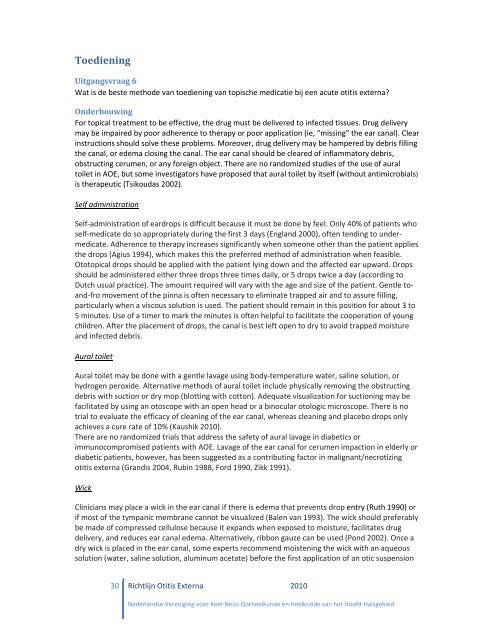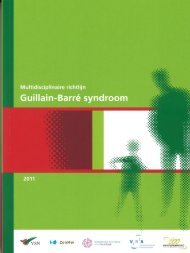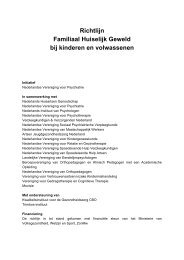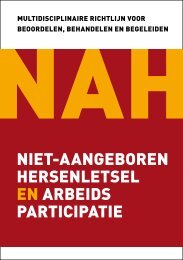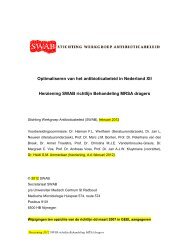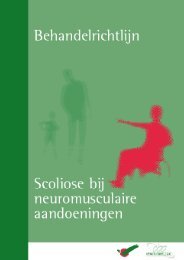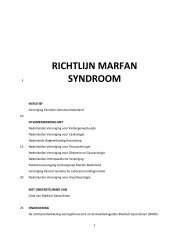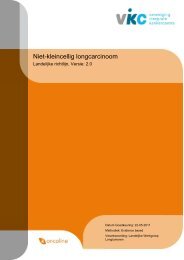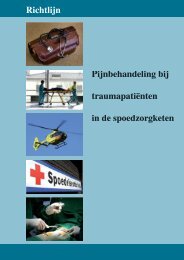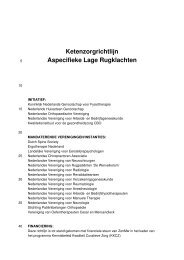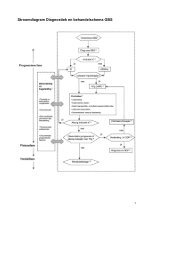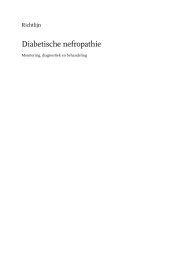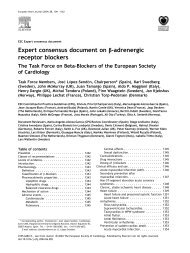Richtlijn: Otitis Externa - Kwaliteitskoepel
Richtlijn: Otitis Externa - Kwaliteitskoepel
Richtlijn: Otitis Externa - Kwaliteitskoepel
You also want an ePaper? Increase the reach of your titles
YUMPU automatically turns print PDFs into web optimized ePapers that Google loves.
Toediening<br />
Uitgangsvraag 6<br />
Wat is de beste methode van toediening van topische medicatie bij een acute otitis externa?<br />
Onderbouwing<br />
For topical treatment to be effective, the drug must be delivered to infected tissues. Drug delivery<br />
may be impaired by poor adherence to therapy or poor application (ie, “missing” the ear canal). Clear<br />
instructions should solve these problems. Moreover, drug delivery may be hampered by debris filling<br />
the canal, or edema closing the canal. The ear canal should be cleared of inflammatory debris,<br />
obstructing cerumen, or any foreign object. There are no randomized studies of the use of aural<br />
toilet in AOE, but some investigators have proposed that aural toilet by itself (without antimicrobials)<br />
is therapeutic (Tsikoudas 2002).<br />
Self administration<br />
Self-administration of eardrops is difficult because it must be done by feel. Only 40% of patients who<br />
self-medicate do so appropriately during the first 3 days (England 2000), often tending to undermedicate.<br />
Adherence to therapy increases significantly when someone other than the patient applies<br />
the drops (Agius 1994), which makes this the preferred method of administration when feasible.<br />
Ototopical drops should be applied with the patient lying down and the affected ear upward. Drops<br />
should be administered either three drops three times daily, or 5 drops twice a day (according to<br />
Dutch usual practice). The amount required will vary with the age and size of the patient. Gentle toand-fro<br />
movement of the pinna is often necessary to eliminate trapped air and to assure filling,<br />
particularly when a viscous solution is used. The patient should remain in this position for about 3 to<br />
5 minutes. Use of a timer to mark the minutes is often helpful to facilitate the cooperation of young<br />
children. After the placement of drops, the canal is best left open to dry to avoid trapped moisture<br />
and infected debris.<br />
Aural toilet<br />
Aural toilet may be done with a gentle lavage using body-temperature water, saline solution, or<br />
hydrogen peroxide. Alternative methods of aural toilet include physically removing the obstructing<br />
debris with suction or dry mop (blotting with cotton). Adequate visualization for suctioning may be<br />
facilitated by using an otoscope with an open head or a binocular otologic microscope. There is no<br />
trial to evaluate the efficacy of cleaning of the ear canal, whereas cleaning and placebo drops only<br />
achieves a cure rate of 10% (Kaushik 2010).<br />
There are no randomized trials that address the safety of aural lavage in diabetics or<br />
immunocompromised patients with AOE. Lavage of the ear canal for cerumen impaction in elderly or<br />
diabetic patients, however, has been suggested as a contributing factor in malignant/necrotizing<br />
otitis externa (Grandis 2004, Rubin 1988, Ford 1990, Zikk 1991).<br />
Wick<br />
Clinicians may place a wick in the ear canal if there is edema that prevents drop entry (Ruth 1990) or<br />
if most of the tympanic membrane cannot be visualized (Balen van 1993). The wick should preferably<br />
be made of compressed cellulose because it expands when exposed to moisture, facilitates drug<br />
delivery, and reduces ear canal edema. Alternatively, ribbon gauze can be used (Pond 2002). Once a<br />
dry wick is placed in the ear canal, some experts recommend moistening the wick with an aqueous<br />
solution (water, saline solution, aluminum acetate) before the first application of an otic suspension<br />
30 <strong>Richtlijn</strong> <strong>Otitis</strong> <strong>Externa</strong> 2010<br />
Nederlandse Vereniging voor Keel-Neus-Oorheelkunde en Heelkunde van het Hoofd-Halsgebied


